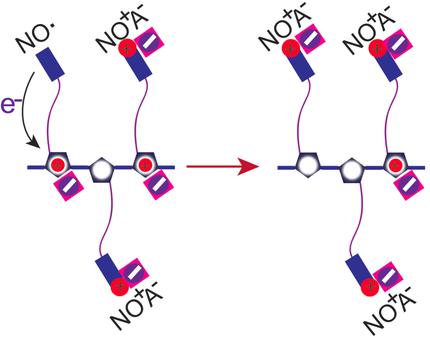当前位置:
X-MOL 学术
›
Angew. Chem. Int. Ed.
›
论文详情
Our official English website, www.x-mol.net, welcomes your
feedback! (Note: you will need to create a separate account there.)
Unusual Internal Electron Transfer in Conjugated Radical Polymers
Angewandte Chemie International Edition ( IF 16.1 ) Pub Date : 2017-07-19 03:02:03 , DOI: 10.1002/anie.201705204 Fei Li 1 , Danielle N Gore 1 , Shaoyang Wang 1 , Jodie L Lutkenhaus 1
Angewandte Chemie International Edition ( IF 16.1 ) Pub Date : 2017-07-19 03:02:03 , DOI: 10.1002/anie.201705204 Fei Li 1 , Danielle N Gore 1 , Shaoyang Wang 1 , Jodie L Lutkenhaus 1
Affiliation

|
Nitroxide-containing organic radical polymers (ORPs) have captured attention for their high power and fast redox kinetics. Yet a major challenge is the polymer's aliphatic backbone, resulting in a low electronic conductivity. Recent attempts that replace the aliphatic backbone with a conjugated one have not met with success. The reason for this is not understood until now. We examine a family of polythiophenes bearing nitroxide radical groups, showing that while both species are electrochemically active, there exists an internal electron transfer mechanism that interferes with stabilization of the polymer's fully oxidized form. This finding directs the future design of conjugated radical polymers in energy storage and electronics, where careful attention to the redox potential of the backbone relative to the organic radical species is needed.
中文翻译:

共轭自由基聚合物中异常的内部电子转移
含一氧化氮的有机自由基聚合物(ORP)以其高功率和快速的氧化还原动力学而备受关注。然而,主要挑战是聚合物的脂族主链,导致低电子电导率。最近用共轭的取代脂肪族骨架的尝试并未获得成功。到目前为止,尚不了解其原因。我们检查了带有氮氧自由基基团的聚噻吩家族,表明尽管这两种物质都具有电化学活性,但存在内部电子转移机制,该机制干扰了聚合物完全氧化形式的稳定性。这一发现指导了储能和电子领域共轭自由基聚合物的未来设计,
更新日期:2017-07-20
中文翻译:

共轭自由基聚合物中异常的内部电子转移
含一氧化氮的有机自由基聚合物(ORP)以其高功率和快速的氧化还原动力学而备受关注。然而,主要挑战是聚合物的脂族主链,导致低电子电导率。最近用共轭的取代脂肪族骨架的尝试并未获得成功。到目前为止,尚不了解其原因。我们检查了带有氮氧自由基基团的聚噻吩家族,表明尽管这两种物质都具有电化学活性,但存在内部电子转移机制,该机制干扰了聚合物完全氧化形式的稳定性。这一发现指导了储能和电子领域共轭自由基聚合物的未来设计,











































 京公网安备 11010802027423号
京公网安备 11010802027423号